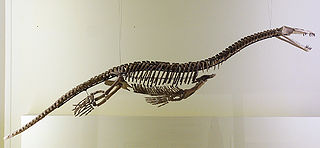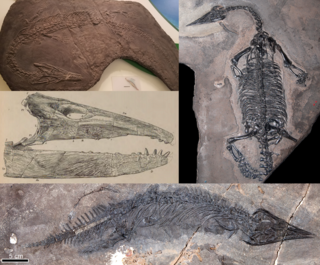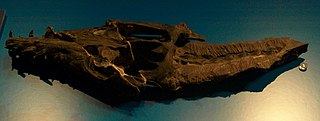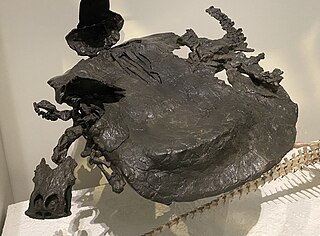
Nothosaurus is an extinct genus of sauropterygian reptile from the Triassic period, approximately 240–210 million years ago, with fossils being distributed from North Africa and Europe to China. It is the best known member of the nothosaur order.

Thalattosauria is an extinct order of marine reptiles that lived in the Middle to Late Triassic. Thalattosaurs were diverse in size and shape, and are divided into two superfamilies: Askeptosauroidea and Thalattosauroidea. Askeptosauroids were endemic to the Tethys Ocean, their fossils have been found in Europe and China, and they were likely semiaquatic fish eaters with straight snouts and decent terrestrial abilities. Thalattosauroids were more specialized for aquatic life and most had unusual downturned snouts and crushing dentition. Thalattosauroids lived along the coasts of both Panthalassa and the Tethys Ocean, and were most diverse in China and western North America. The largest species of thalattosaurs grew to over 4 meters (13 feet) in length, including a long, flattened tail utilized in underwater propulsion. Although thalattosaurs bore a superficial resemblance to lizards, their exact relationships are unresolved. They are widely accepted as diapsids, but experts have variously placed them on the reptile family tree among Lepidosauromorpha, Archosauromorpha, ichthyosaurs, and/or other marine reptiles.

Macrocnemus is an extinct genus of archosauromorph reptile known from the Middle Triassic of Europe and China. Macrocnemus is a member of the Tanystropheidae family and includes three species. Macrocnemus bassanii, the first species to be named and described, is known from the Besano Formation and adjacent paleontological sites in the Italian and Swiss Alps. Macrocnemus fuyuanensis, on the other hand, is known from the Zhuganpo Formation in southern China. A third species, Macrocnemus obristi, is known from the Prosanto Formation of Switzerland and is characterized by gracile limbs. The name Macrocnemus is Greek for "long tibia".
Dactylosaurus is a genus of nothosaur in the family Pachypleurosauridae. Along with Anarosaurus, Dactylosaurus was one of the earliest known pachypleurosaurs to come from Europe.

Augustasaurus is an extinct genus of sauropterygians that lived during the Anisian stage of the Middle Triassic in what is now North America. Only one species is known, A. hagdorni, described in 1997 from fossils discovered in the Favret Formation, Nevada, USA.

Helveticosaurus is an extinct genus of diapsid marine reptile known from the Middle Triassic of southern Switzerland. It contains a single species, Helveticosaurus zollingeri, known from the nearly complete holotype T 4352 collected at Cava Tre Fontane of Monte San Giorgio, an area well known for its rich record of marine life during the Middle Triassic.
The Guanling Formation is a Middle Triassic geologic formation in southwestern China.

Henodus is an extinct placodont of the Late Triassic period during the early Carnian age. Fossils of Henodus chelyops were found in the Estherienschichten Member of the Grabfeld Formation, near Tübingen, Germany. It was around 1 metre (3.3 ft) in length. The single species within the genus is H. chelyops.

Sinosaurosphargis is an extinct genus of basal marine saurosphargid reptile known from the Middle Triassic Guanling Formation of Yunnan and Guizhou Provinces, southwestern China. It contains a single species, Sinosaurosphargis yunguiensis.
Diandongosaurus is an extinct genus of eosauropterygian known from the lower Middle Triassic of Yunnan Province, southwestern China. It is known from the holotype IVPP V 17761, a complete and articulated skeleton with skull, which was found in the middle Triassic Lagerstätte of the Guanling Formation. It was first named by Qing-Hua Shang, Xiao-Chun Wu, Chun Li in 2011 and the type species is Diandongosaurus acutidentatus. A referred specimen suggests a total body length of 34 cm (13 in).
Largocephalosaurus is an extinct genus of basal saurosphargid, a marine reptile known from the Middle Triassic Guanling Formation of Yunnan and Guizhou Provinces, southwestern China. It contains a type species, Largocephalosaurus polycarpon, and a second species L. qianensis.
Sanchiaosaurus is an extinct genus of a basal nothosauroid known from the Middle Triassic of Guizhou Province, southwestern China. It contains a single species, Sanchiaosaurus dengi.
Germanosaurus, meaning "German lizard", is an extinct aquatic genus of nothosaurid sauropterygian known from the early Middle Triassic Lower Muschelkalk of what was known as Upper Silesia, now a part of Poland. The type species of Germanosaurus is G. latissimus, originally named as a species of Nothosaurus. After a new generic name was erected for it, the holotype fragmentary skull was lost, possibly during World War II. Rieppel (1997) thus considered the species to be a nomen dubium in the species. However, from surviving illustrations and descriptions of the material, he concluded that another taxon known as Cymatosaurus schafferi, is referable to Germanosaurus and possibly even represents the same species as G. latissimus. Rieppel removed the species from Cymatosaurus and created the new combination G. schafferi, making it the only valid species of Germanosaurus diagnosable to the species level.

Saurosphargidae is an extinct family of marine reptiles known from the Early Triassic and early Middle Triassic of Europe and China.

Eusaurosphargis is an extinct genus of a diapsid reptile, known from the Middle Triassic Besano Formation of northern Italy and Prosanto Formation of south-eastern Switzerland. It contains a single species, Eusaurosphargis dalsassoi. It was a small reptile, measuring 20 cm (7.9 in) long.

Helveticosauridae is an extinct family of basal marine reptiles known from the Middle Triassic of southern Switzerland and northern Italy.
Eorhynchochelys is an extinct genus of stem-turtle from the Late Triassic Xiaowa Formation of southwestern China.
The Zhuganpo Formation is a Triassic geologic unit found in southern China. It has historically been known as the Zhuganpo Member of the Falang Formation. A diverse fossil assemblage known as the Xingyi biota or Xingyi Fauna can be found in the upper part of the Zhuganpo Formation. Fossils of the Xingyi biota include articulated skeletons of marine reptiles, abundant fish, and a plentiful assortment of invertebrates indicating a Ladinian to Carnian age for the sediments of the formation.
This list of fossil reptiles described in 2014 is a list of new taxa of fossil reptiles that were described during the year 2014, as well as other significant discoveries and events related to reptile paleontology that occurred in 2014.














